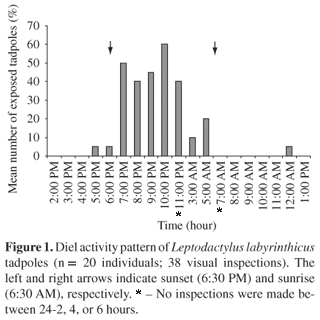Leptodactylus labyrinthicus tadpoles reach a large size in the nest through consumption of trophic eggs. We previously suggested that the trophic eggs are laid just after amplexus has finished, but our new data do not support this hypothesis. We also present further details on the natural history of the species with regard to breeding activity, spawning site, retreats and the ability of tadpoles in preying upon fully-growth heterospecific tadpoles. We also show that the tadpoles are mainly nocturnal and take diurnal refuges. We collected the data in Brazil in three localities within the Cerrado Biome. We examined burrows used by L. labyrinthicus males, verified if females still contained mature eggs just after released from amplexus, and tested the ability of tadpoles in preying fully-growth heterospecific tadpoles. Field observations and experiments were conducted on tadpole activity time, hiding behaviour and level of susceptibility to predation by the bird leaf-scrapers in four sheltering situations. Reproduction could start before the first rains; this may be advantageous by allowing the tadpoles to exploit eggs of other frogs. We found one floating nest built in a temporary pool. The nest of the species is normally circumscribed in an excavated basin beside the water body. Adult males were found during the day with their head-out of the entrance of underwater burrows, which were perforations through dense root mats beside calling/spawning sites. Probably, these burrows in permanently water-filled soil are actively excavated by males. Females released all their eggs during the amplexus, so trophic eggs are not produced by the currently-accepted mechanism. Fully-grown heterospecific tadpoles were not preyed upon by L. labyrinthicus tadpoles, which can prey only slow-moving newly hatched ones. Field tadpoles took shelter under mud/dead leaves during daylight and became exposed on the bottom at night. Free-ranging leaf-scrapers removed dead leaves from a pool with their beaks and preyed upon tadpoles. In the experiments, the tadpoles sheltered under gravel/leaves during daylight, but they were exposed at night. Leaf-scrapers ate all exposed tadpoles, but no tadpole of the gravel/leaves trays was consumed. Hence the nocturnal habits and use of diurnal refuges may protect the tadpoles from visual predators, such as the leaf-scrapers.
Leptodactylus pentadactylus group; reproduction; retreats; trophic eggs; tadpoles

